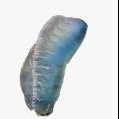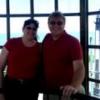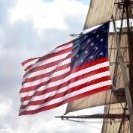-
Posts
1,242 -
Joined
-
Last visited
Reputation Activity
-
 Papa got a reaction from Srodbro in Charles W Morgan by Papa - FINISHED - Model Shipways - 1/64th scale
Papa got a reaction from Srodbro in Charles W Morgan by Papa - FINISHED - Model Shipways - 1/64th scale
The Morgan is essentially finished. One little line to trim when I get around to it.
-
 Papa got a reaction from John Ruy in Charles W Morgan by Papa - FINISHED - Model Shipways - 1/64th scale
Papa got a reaction from John Ruy in Charles W Morgan by Papa - FINISHED - Model Shipways - 1/64th scale
Thanks. She has been done for a while. I just neglected to post a photo.
-
 Papa got a reaction from ccoyle in Charles W Morgan by Papa - FINISHED - Model Shipways - 1/64th scale
Papa got a reaction from ccoyle in Charles W Morgan by Papa - FINISHED - Model Shipways - 1/64th scale
The Morgan is essentially finished. One little line to trim when I get around to it.
-
 Papa got a reaction from Rik Thistle in Charles W Morgan by Papa - FINISHED - Model Shipways - 1/64th scale
Papa got a reaction from Rik Thistle in Charles W Morgan by Papa - FINISHED - Model Shipways - 1/64th scale
The Morgan is essentially finished. One little line to trim when I get around to it.
-
 Papa got a reaction from ERS Rich in Charles W Morgan by Papa - FINISHED - Model Shipways - 1/64th scale
Papa got a reaction from ERS Rich in Charles W Morgan by Papa - FINISHED - Model Shipways - 1/64th scale
The Morgan is essentially finished. One little line to trim when I get around to it.
-
 Papa got a reaction from Srodbro in Charles W Morgan by Papa - FINISHED - Model Shipways - 1/64th scale
Papa got a reaction from Srodbro in Charles W Morgan by Papa - FINISHED - Model Shipways - 1/64th scale
Cutting stage built and hung
-
 Papa got a reaction from Thukydides in Gjoa by Papa - FINISHED - Model Shipways - 5/32” = 1’ - old solid hull kit
Papa got a reaction from Thukydides in Gjoa by Papa - FINISHED - Model Shipways - 5/32” = 1’ - old solid hull kit
We had an oopsie while rigging the main braces and knocked off the dolphin striker and associated rigging. One step forward two steps backward. A new striker is in place and waiting for the riggers.
-
 Papa reacted to petervisser in Gjoa by Papa - FINISHED - Model Shipways - 5/32” = 1’ - old solid hull kit
Papa reacted to petervisser in Gjoa by Papa - FINISHED - Model Shipways - 5/32” = 1’ - old solid hull kit
Hi Papa,
Just discovered your build log of the Gjoa. What a great model you have on the go. The reason I am writing is the fact that I visited Gjoa Haven (Uqsuqtuuk) back in 2003 when I sailed aboard the CCGS Sir Wilfrid Laurier. Your model brought back some memories of the time I visited there and I thought you might be interested in seeing a few photos I took while I was ashore. I have also added a photo of a promotional poster the territorial government issued to entice some tourism.
Amundsen must have been a pretty guttsy guy to take on the Northwest Passage in such a vessel as the Gjoa. All the best going forward with your model.
Cheers,
Peter
-
 Papa got a reaction from KevinR in Gjoa by Papa - FINISHED - Model Shipways - 5/32” = 1’ - old solid hull kit
Papa got a reaction from KevinR in Gjoa by Papa - FINISHED - Model Shipways - 5/32” = 1’ - old solid hull kit
Boom and gaff are in. Now I am tying ratlines, my least favorite part of rigging.
-
 Papa got a reaction from KevinR in Gjoa by Papa - FINISHED - Model Shipways - 5/32” = 1’ - old solid hull kit
Papa got a reaction from KevinR in Gjoa by Papa - FINISHED - Model Shipways - 5/32” = 1’ - old solid hull kit
We had an oopsie while rigging the main braces and knocked off the dolphin striker and associated rigging. One step forward two steps backward. A new striker is in place and waiting for the riggers.
-
 Papa got a reaction from Harvey Golden in Gjoa by Papa - FINISHED - Model Shipways - 5/32” = 1’ - old solid hull kit
Papa got a reaction from Harvey Golden in Gjoa by Papa - FINISHED - Model Shipways - 5/32” = 1’ - old solid hull kit
We had an oopsie while rigging the main braces and knocked off the dolphin striker and associated rigging. One step forward two steps backward. A new striker is in place and waiting for the riggers.
-
 Papa got a reaction from Harvey Golden in Gjoa by Papa - FINISHED - Model Shipways - 5/32” = 1’ - old solid hull kit
Papa got a reaction from Harvey Golden in Gjoa by Papa - FINISHED - Model Shipways - 5/32” = 1’ - old solid hull kit
Boom and gaff are in. Now I am tying ratlines, my least favorite part of rigging.
-
 Papa got a reaction from Harvey Golden in Gjoa by Papa - FINISHED - Model Shipways - 5/32” = 1’ - old solid hull kit
Papa got a reaction from Harvey Golden in Gjoa by Papa - FINISHED - Model Shipways - 5/32” = 1’ - old solid hull kit
Have the main shrouds in now.
-
 Papa reacted to xodar461 in Foss Landing and The shipyard at Foss Landing by xodar461 - Sierra West Scale Models - 1/87
Papa reacted to xodar461 in Foss Landing and The shipyard at Foss Landing by xodar461 - Sierra West Scale Models - 1/87
Greetings!
It has been a while since my last post but work proceeds on Foss Landing. I have completed the Addison and here are a few photos. Construction is quite similar to the Jewel so there is no need to repeat. As with the Jewel, I chose to rig with scale blocks and rope, using turnbuckles for the standing rigging. The arrows on the photo below were for a brief tutorial on rigging that can be found on the Sierra West forum.
I will probably add some more details like netting, spare rope and barrels at a later time.
This completes the structures of Foss Landing. Here are some photos of them all laid out like in the diorama.
And here is a photo of some HO scale add-ons that can be seen in the photos above.
Next up: finishing the barrels, oil drums and trash cans, then onto the Shipyard.
Jeff
-
 Papa got a reaction from Coyote_6 in Gjoa by Papa - FINISHED - Model Shipways - 5/32” = 1’ - old solid hull kit
Papa got a reaction from Coyote_6 in Gjoa by Papa - FINISHED - Model Shipways - 5/32” = 1’ - old solid hull kit
Boom and gaff are in. Now I am tying ratlines, my least favorite part of rigging.
-
 Papa reacted to mgdawson in Help with translation of rigging term
Papa reacted to mgdawson in Help with translation of rigging term
Hmm ChatGPT says pretty much the same thing, maybe it's the bosuns belaying pin for giving slackers the hurry up 😂
-
 Papa got a reaction from mtaylor in Help with translation of rigging term
Papa got a reaction from mtaylor in Help with translation of rigging term
The belaying key labels on my Gjoa sail plan are all in English except for one pin labeled ørefiken. I assume this is Norwegian as Gjoa was a Norwegian ship. Can someone translate this for me? Google translate isn’t helpful. It says it means cuff or slap on the face.
thanks
-
 Papa got a reaction from Keith Black in Help with translation of rigging term
Papa got a reaction from Keith Black in Help with translation of rigging term
The belaying key labels on my Gjoa sail plan are all in English except for one pin labeled ørefiken. I assume this is Norwegian as Gjoa was a Norwegian ship. Can someone translate this for me? Google translate isn’t helpful. It says it means cuff or slap on the face.
thanks
-
 Papa got a reaction from Coyote_6 in Gjoa by Papa - FINISHED - Model Shipways - 5/32” = 1’ - old solid hull kit
Papa got a reaction from Coyote_6 in Gjoa by Papa - FINISHED - Model Shipways - 5/32” = 1’ - old solid hull kit
Have the main shrouds in now.
-
 Papa got a reaction from Srodbro in Gjoa by Papa - FINISHED - Model Shipways - 5/32” = 1’ - old solid hull kit
Papa got a reaction from Srodbro in Gjoa by Papa - FINISHED - Model Shipways - 5/32” = 1’ - old solid hull kit
Have the main shrouds in now.
-
 Papa reacted to Doug McKenzie in Santa Maria, Pinta and Nina by Doug McKenzie - FINISHED - Heller - 1:75
Papa reacted to Doug McKenzie in Santa Maria, Pinta and Nina by Doug McKenzie - FINISHED - Heller - 1:75
In this post, we'll show how we will neutralize the different scales of the nao (Santa Maria) 1 to 78 and the caravels (Nina and Pinta) 1 to 100. In Pic 1 the trio is shown lined up with each other. The Santa Maria dwafs the two caravels inappropriately because the scales are different.
In Pic 2, the Santa Maria has been pushed back about 14" so that she is on a parallel course to the caravels but displaced from their course line. Letting the caravels remain at a scale of 1 to 100, the scale of Santa Maria appears to have been increased from 1 to 78 up to 1 to 95. In the actual placement, where the hulls will be displayed, the apparent scale will probable be a little less.
Well, I have disappointing news. I started to make the changes to the stern upper profiles of Nina and Santa Maria and it became apparent that it would ruin some of the clean sweeps of the wales and planks so I have decided to leave them as is. I still take pleasure in the technique of equalizing the scales of the nao and the caravels, though.
-
 Papa reacted to Doug McKenzie in Santa Maria, Pinta and Nina by Doug McKenzie - FINISHED - Heller - 1:75
Papa reacted to Doug McKenzie in Santa Maria, Pinta and Nina by Doug McKenzie - FINISHED - Heller - 1:75
Having fessed up to a serious mistake, I will now attempt to rectify the situation by comparing Nina and Pinta between Heller and Hidalgo PROPERLY. Pic 1 shows both ships as Heller models them to be the same. Notice that even the 'transoms' are the same. btw If I remember, I'll always show Nina in front of Pinta because she was more maneuverable and probably pretty much as fast. Similarly, Santa Maria will always bring up the rear. This part of the hull is reflected in the main dimensions that were compared in Post 2.
Pic 2 shows them different in their fore and aft 'vertical ascensions' - Nina has no rise in the bow and a short rise in the stern while Pinta has a short rise in the bow and a long rise in the stern. [The mistake that I made earlier was assuming they both had the short rise in the bow and the short rise in the stern. Let's not discuss how such a mistake was made.]
Pic 3 shows the comparison of Heller's Nina (red) to Hildago's (black). Overall, it is a close match except for the stern's upper profile for which Heller is both higher and steeper.
Pic 4 shows the comparison of Heller's Pinta (red) to Hildago's (black). Overall, it is a good match except for the bow's upper profile for which Heller is higher but at the same slope. Also, Heller's stem is much fuller that Hidalgo's. It must be that Pinta's stem was fuller than Nina's and that the two lower, identical Heller stems happened to match Nina's stem. If we add some comments on Santa Maria we can then discuss remidiation. In Pic 1 of post 4 the profiles of Santa Maria were compared. It is noted here that the stern upper profile of Heller's was lower and less steep than Hidalgo's.
Focusing on the stern upper profile we quantify one of the differences in Pic 5 using the slant of the stern upper profile measured in degrees. We focus on the slant because it is very discernable to the eye.
The first thing to note is that the varistion in the Hidalgo's slants (7 to 10) is much smaller than for Helller (3 to 13). Combining this with Hidalgo's statement that "much less is known about Pinta than the other ships," we could duduce that the slants for all three ships was near 8. Our target will be to decrease Heller's Nina from 13 to 8 degrees, leave his Pinta's at 10 and increase his Santa Maria's from 3 to 8.
The next thing to quantify is the verticle position of the stern upper profile. Note that these dispacements not only line up the stern upper profiles better but they also fix the slants.
The key points of interest are the aft most point on the stern upper profile and the forward most point of that profile. Heller's aft most point for Nina needs to drop 7 mm while the forward most point stays where it is. The aft most point for Pinta should be dropped 3 mm as well as the forward most point but we will leave Pinta alone since the difference is small and the slant does not need to be corrected either. The aft most point for Santa Maria needs to be raised 11 mm and the forward most point raised 7 mm.
We will not be trying to fix Pinta's forward upper profile because the slant is quite close and the displacement is modest. Nor will we try to fix Pinta's stem because it would be very difficult. In the next post, we'll show how we will neutralize the different scales of the nao (Santa Maria) 1 to 78 and the caravels (Nina and Pinta) 1 to 100. Then we will return to the modifications of the stern upper profiles.
-
 Papa reacted to Doug McKenzie in Santa Maria, Pinta and Nina by Doug McKenzie - FINISHED - Heller - 1:75
Papa reacted to Doug McKenzie in Santa Maria, Pinta and Nina by Doug McKenzie - FINISHED - Heller - 1:75
Pic 1 shows the 3 hulls with all their fittings on viewed midship forward. Pic 2 is the same but viewed midship aft.
Next, we'll show all 3 ships with their masts stepped discussing the modifications that have been made to implement Hidalgo's mast dimensions and locations as best we can. This is also a good time to compare 19th century American and British masting practices with late 15th century Spanish and Portugese practices.
Santa Maria
First, we compare the mainmasts. 1) Heller's Santa Maria mainmast has pretty much the same length as Hidalgo's. 2) The diameter at the partners, however, is only 85% as big. I'm guessing that the full diameter looks too fat to the modern eye so Heller reduces it somewhat. In the 19th century, a mast the same length would have been even skinnier, about 75% as big in diameter as Hidalgo's. 3) Interestingly, the taper of Heller's mast (diameter at the hounds / diameter at the partners), 57%, is about the same as Hidalgo's, 62% whereas in the 19th century, there was less taper at 75%.
Second, we discuss the mast rakes. Heller follows Hidalgo closely with mainmasts being vertical, foremasts having a slight rake forward and mizzen masts having rake aft. By the 19th century, all masts raked aft with the least rake forward and the most rake aft.
Third, the foremasts and mizzen masts. This discussion needs to include the sails since they are affected by changes in the masts. As with the mainmast, Heller's mainsail is in good proportion to Hidalgo's. However, both the foremast and the mizzen mast had to be shortened to about 70% of Heller's height to match Hidalgo's and this directly effects the sail's heights also. The sail area of the foresail is reduced to 70% but the area of the mizzen is reduced to about 50% of Heller's original because it is a lateen sail and the foot is reduced by 70% as the height is reduced. The mizzen mast also had to move forward so that the sheet of the mizzen sail can be taken to the taffrail since Hidalgo does not support Heller's boomkin. Hidalgo points out that the mainsail of a nao is by far the main contributor to the speed of the ship; the other sails are mainly for balance to aid in steering.
Pinta
The main and mizzen masts as well as the bowsprit were fine but Heller's foremast needed to be shortened to about 90% of the original. Hidalgo does not give info on mast diameters for Pinta or Nina so we cannot make any comparisons.
Nina
Both main and mizzen masts of Heller's were in good proportion to Hidalgo's.
The next post wil show the shrouds of the three ships.
-
 Papa reacted to Doug McKenzie in Santa Maria, Pinta and Nina by Doug McKenzie - FINISHED - Heller - 1:75
Papa reacted to Doug McKenzie in Santa Maria, Pinta and Nina by Doug McKenzie - FINISHED - Heller - 1:75
Now we proceed to complete the raised fo'c'sle. Pic 1 shows 3 of the slanted planks that connect the raised fo'c'sle to the top of the caravel bow. Hidalgo clearly shows this slant but it wasn't clear to me why it appears. The combination of the platform overhanging the stem and starting the planking at the bow induces the slant.. Pic 2 shows the completed planking.
happens
Pic 3 shows the panel borders which sort of mimic the open rail at the stern. The large arch is seen in this Pic also. There are no hints as to the purpose of this planked surface with an arch in it. Pic 4 shows the completed platform after being coated with whale oil and fish oil. At this point, I can say that how the decks were treated is not described. Heller uses a tan to represent that unknown treatment.
Pic 5 shows the whole ship with the completed bow platform.
-
 Papa reacted to DB789 in Ranger 1864 by DB789 - FINISHED - Vanguard Models - 1:64 - Barking Fish Carrier
Papa reacted to DB789 in Ranger 1864 by DB789 - FINISHED - Vanguard Models - 1:64 - Barking Fish Carrier
First planking complete. This continued to be easy and straightforward. I could plank her with no edge bending or soaking of planks. Probably would have resulted in a tidier finish if I had edge bent a few of the tougher planks and will do so for the second planking.
Then nails removed and sanded. No filler yet.
Then the rabbets and inner stern board fitted and clamped to dry.
I found that I needed to unglue and sand the tops of the outer stern frames so these were the same shape as the stern board.











